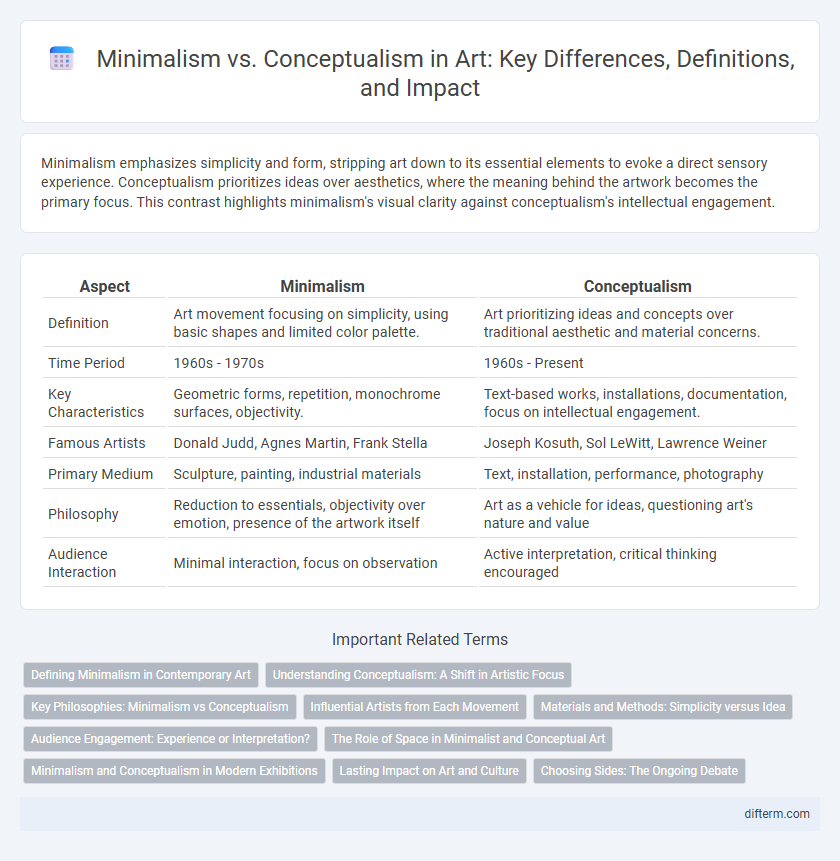Minimalism emphasizes simplicity and form, stripping art down to its essential elements to evoke a direct sensory experience. Conceptualism prioritizes ideas over aesthetics, where the meaning behind the artwork becomes the primary focus. This contrast highlights minimalism's visual clarity against conceptualism's intellectual engagement.
Table of Comparison
| Aspect | Minimalism | Conceptualism |
|---|---|---|
| Definition | Art movement focusing on simplicity, using basic shapes and limited color palette. | Art prioritizing ideas and concepts over traditional aesthetic and material concerns. |
| Time Period | 1960s - 1970s | 1960s - Present |
| Key Characteristics | Geometric forms, repetition, monochrome surfaces, objectivity. | Text-based works, installations, documentation, focus on intellectual engagement. |
| Famous Artists | Donald Judd, Agnes Martin, Frank Stella | Joseph Kosuth, Sol LeWitt, Lawrence Weiner |
| Primary Medium | Sculpture, painting, industrial materials | Text, installation, performance, photography |
| Philosophy | Reduction to essentials, objectivity over emotion, presence of the artwork itself | Art as a vehicle for ideas, questioning art's nature and value |
| Audience Interaction | Minimal interaction, focus on observation | Active interpretation, critical thinking encouraged |
Defining Minimalism in Contemporary Art
Minimalism in contemporary art emphasizes simplicity, using basic geometric forms and monochromatic palettes to strip away excess. It prioritizes the viewer's interaction with the artwork's physical space and materiality over narrative or symbolism. This approach contrasts with conceptualism by focusing on tangible visual elements rather than ideas or concepts behind the work.
Understanding Conceptualism: A Shift in Artistic Focus
Conceptualism redefines art by prioritizing ideas over visual aesthetics, emphasizing intellectual engagement rather than mere sensory experience. Unlike minimalism's focus on simplicity and form, conceptual art challenges viewers to interpret underlying meanings and question traditional artistic values. This shift in artistic focus transforms the creative process into a dialogue between artist, concept, and audience, expanding the boundaries of contemporary art.
Key Philosophies: Minimalism vs Conceptualism
Minimalism emphasizes simplicity, stripping art to its fundamental features, often using geometric shapes and monochromatic palettes to highlight purity and objectivity. Conceptualism prioritizes ideas over aesthetic form, asserting that the concept or idea behind the artwork holds more importance than its physical manifestation. Key philosophies contrast Minimalism's focus on material presence and sensory experience with Conceptualism's reliance on intellectual engagement and critical thought.
Influential Artists from Each Movement
Minimalism is defined by artists such as Donald Judd and Agnes Martin, who emphasized simplicity, geometric forms, and the reduction of art to essential elements. Conceptualism, led by figures like Sol LeWitt and Joseph Kosuth, prioritizes ideas over visual aesthetics, often using language and documentation as primary mediums. Both movements revolutionized contemporary art by challenging traditional notions of form, interpretation, and the role of the artist.
Materials and Methods: Simplicity versus Idea
Minimalism emphasizes simplicity through the use of industrial materials like steel, glass, and concrete, focusing on clean lines and geometric forms to create aesthetic purity. Conceptualism prioritizes ideas over physical form, often employing unconventional materials and methods such as text, performance, and documentation to challenge traditional notions of art. While minimalism reduces art to essential elements, conceptualism expands meaning by foregrounding intellectual engagement and interpretation.
Audience Engagement: Experience or Interpretation?
Minimalism engages the audience primarily through direct sensory experience, emphasizing simplicity and physical presence that invites viewers to explore space, form, and materiality. Conceptualism prioritizes intellectual engagement, encouraging interpretation and critical thought about ideas, context, and meaning behind the artwork. The contrast lies in minimalism's experiential impact versus conceptualism's invitation to decode and contemplate artistic concepts.
The Role of Space in Minimalist and Conceptual Art
The role of space in minimalist and conceptual art serves as a fundamental element shaping the viewer's experience and interpretation. Minimalist art utilizes space to emphasize simplicity, order, and the physical presence of objects, often employing empty or negative space to highlight form and structure. Conceptual art challenges traditional spatial perceptions by prioritizing ideas over objects, using space as a conceptual framework that transforms the gallery into a site for intellectual engagement rather than mere visual appreciation.
Minimalism and Conceptualism in Modern Exhibitions
Minimalism emphasizes simplicity and geometric forms, often using industrial materials to create a direct and unembellished visual experience in modern exhibitions. Conceptualism prioritizes ideas over aesthetic, with artworks serving as vessels for intellectual engagement, frequently involving text, documentation, or performance elements. Contemporary galleries highlight the contrast between Minimalism's material presence and Conceptualism's cerebral approach, reflecting evolving art narratives in the 21st century.
Lasting Impact on Art and Culture
Minimalism's lasting impact on art and culture is characterized by its emphasis on simplicity, geometric forms, and the reduction of elements to their essentials, influencing modern design, architecture, and visual arts with a focus on clarity and function. Conceptualism shifted the art paradigm by prioritizing ideas over aesthetics, challenging traditional notions of art and inspiring movements that value intellectual engagement and critical thought. Both movements redefined artistic boundaries, fostering innovation and encouraging audiences to reconsider the relationship between art, meaning, and societal context.
Choosing Sides: The Ongoing Debate
Minimalism emphasizes simplicity, focusing on geometric forms and reducing art to its essential elements, while conceptualism prioritizes ideas and the process over the physical object. The ongoing debate between these movements challenges artists and critics to evaluate the value of form versus meaning in contemporary art. Choosing sides reflects broader discussions about the role of interpretation and materiality in shaping artistic experience.
minimalism vs conceptualism Infographic

 difterm.com
difterm.com